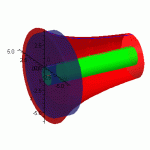Here's the problem I have.
Consider the solid obtained by rotating the region bounded by the given curves about the line y = -1
Given curves: \(\displaystyle y=\frac{4}{x}, y=0, x=1, x=3\)
Find the volume V of this solid.
I sketched the the graph of the function and found the radii where the "inner" radius = 1 and the "outer" radius = \(\displaystyle 1+\frac{4}{x}\)
And from there I got:
\(\displaystyle V=\int_{1}^{3}\pi((1+\frac{4}{x})^2-1^2))dx\)
However, when I try to integrate it, I get an undefined number.
\(\displaystyle \int_{1}^{3}\pi((1+\frac{4}{x})^2-1^2))dx\)
\(\displaystyle =\pi \int_{1}^{3}((1+\frac{8}{x}+\frac{16}{x^2})-1)dx\)
\(\displaystyle =\pi \int_{1}^{3}(\frac{8}{x}+\frac{16}{x^2})dx\)
\(\displaystyle =\pi (\frac{8x^{(-1+1)}}{-1+1}}+\frac{16x^{(-2+1)}}{-2+1})\mid _{1}^{3}\)
I thought I knew how to solve the problem, but I'm not sure which part I messed up, so any help would be appreciated.
Consider the solid obtained by rotating the region bounded by the given curves about the line y = -1
Given curves: \(\displaystyle y=\frac{4}{x}, y=0, x=1, x=3\)
Find the volume V of this solid.
I sketched the the graph of the function and found the radii where the "inner" radius = 1 and the "outer" radius = \(\displaystyle 1+\frac{4}{x}\)
And from there I got:
\(\displaystyle V=\int_{1}^{3}\pi((1+\frac{4}{x})^2-1^2))dx\)
However, when I try to integrate it, I get an undefined number.
\(\displaystyle \int_{1}^{3}\pi((1+\frac{4}{x})^2-1^2))dx\)
\(\displaystyle =\pi \int_{1}^{3}((1+\frac{8}{x}+\frac{16}{x^2})-1)dx\)
\(\displaystyle =\pi \int_{1}^{3}(\frac{8}{x}+\frac{16}{x^2})dx\)
\(\displaystyle =\pi (\frac{8x^{(-1+1)}}{-1+1}}+\frac{16x^{(-2+1)}}{-2+1})\mid _{1}^{3}\)
I thought I knew how to solve the problem, but I'm not sure which part I messed up, so any help would be appreciated.

